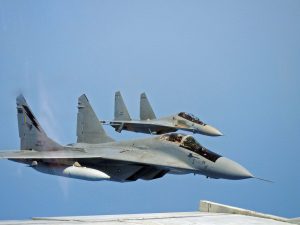China has once again flexed its muscles against Malaysian claims in the South China Sea, this time using airpower and not the typical deployment of coast guard vessels or maritime militia. On the afternoon of May 31, the People’s Liberation Army Air Force (PLAAF) flew 16 aircraft consisting of Ilyushin Il-76 and Xian Y-20 multi-role airlifters over Malaysian maritime zone airspace close to Sarawak.
According to the Royal Malaysian Air Force (RMAF), a squadron of PLAAF aircraft flew in tactical formation and passed close to South Luconia Shoals, which is administered by Malaysia and lies inside Malaysia’s Exclusive Economic Zone (EEZ) but is claimed by China as part of its expansive “nine-dash line” claim. RMAF ground controllers contacted the PLAAF aircraft for identification and intent of flight but received no response, which prompted the RMAF to scramble Hawk 208 light combat aircraft (LCA) to intercept and visually identify the aircraft. Once intercepted by the RMAF LCAs, the PLAAF aircraft turned and flew out.
This latest “buzzing” of Malaysia’s air defenses by the PLAAF is possibly intended to test the country’s air defense response and gather electronic intelligence, such as the RMAF’s radar signature and scrambling time. It may also be linked to its strategy of asserting its control over almost the entirely of the South China Sea. In recent years, China has regularly sent coast guard and maritime militia vessels into Malaysia’s EEZ. In April 2020, China sent a survey ship, the Haiyang Dizhi 8, with 10 coast guard and maritime militia vessels to shadow a Petronas contracted oil exploration ship about 324 kilometers from the Malaysian coast. This prompted the U.S. Navy and Royal Australian Navy to send a small flotilla of combat vessels to the scene to check on the Chinese maritime operations. After spending a few days in the area, the Chinese, U.S., and Australian vessels quietly moved out.
Early this year, China conducted another brazen act in the South China Sea, which serves as a stark reminder to Malaysia to be always vigilant and have sufficient military assets to deter a similar act. On March 7, a large armada of more than 200 Chinese fishing boats docked on Philippine-claimed Whitsun Reef (known as Julian Felipe Reef to Manila), close to the western Philippine province of Palawan in the South China Sea. This latest act of assertiveness by China has resulted in angry protests from numerous Filipino politicians and officials, and continued to foster worries on future Chinese actions in the South China Sea.
The recent PLAAF flight over Malaysia’s maritime zone airspace may point to a potentially more aggressive stance in which airpower may be used to deploy assets and manpower to occupy claimed islands and reefs in the South China Sea. This means that the Malaysian Armed Forces need to acquire not only additional naval vessels but also air defense assets to safeguard Malaysia’s national interests, especially in its vast South China Sea maritime zone and airspace above it, and to provide a credible deterrent against would-be foreign aggressors.
The key defense capability-building plans for the Malaysian Armed Forces have been spelled out in Malaysia’s first Defense White Paper, which was approved by the Parliament in 2019. Among some of the key assets and capabilities required in this decade are the development of cyber warfare and amphibious capabilities for the Malaysian Army, the acquisition and building of Littoral Mission Ships (LMS) for the Royal Malaysian Navy (RMN), and the procurement of Maritime Patrol Aircraft (MPA) and modern Light Combat Aircraft (LCA) for the RMAF. The Hawk 208 LCAs used to intercept the PLAAF this week have been in service for more than 25 years and urgently need to be complemented by modern LCAs. The RMAF may also need to expedite the acquisition of additional air defense radars and medium-range air defense systems (MERAD), as laid out in the 2019 Defense White Paper.
The ongoing COVID-19 pandemic may result in an economic slowdown and many understandably worry about the impact of pandemic on Malaysia’s economy and whether defense procurement and capability-building for the Malaysian Armed Forces might be forced onto the back burner. In times of financial austerity, the defense sector usually gets the first cut to offset budgetary trimmings elsewhere.
Nonetheless, despite the possible economic pressures posed by COVID-19 and the importance of continuous financial support for the health sector and those affected by the disease, the defense sector must not be sidelined. Strategic threats and security risks continue to increase and will reach a stage where core national interests may be lost in the absence of sufficient assets and capabilities to deter or disrupt a potential foe from impinging on Malaysian sovereignty. Once a key national asset is lost, it is very hard to recover, short of using armed violence.
Malaysia has to balance its strategic ends and means deftly. Amid the COVID-19 pandemic, the Malaysian defense sector needs to be allocated sufficient funds to at least sustain a minimal level of capability-building in the most important areas. The sustained defense modernization plans will also send strong signals to near-peers and foreign powers that Malaysia is serious in safeguarding its national interests. A modernized and more potent Malaysian Armed Forces will not just deliver credible deterrence, but will also serve as a compelling adjunct to Malaysia’s traditional use of diplomacy to resolve external crises.

































